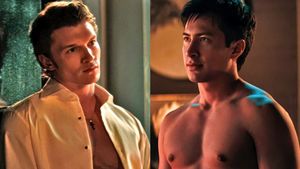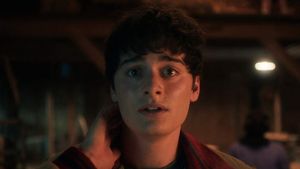1. Parting Glances

Writer and director Bill Sherwood would never make another film—he succumbed to an AIDS-related disease in 1990—but his only cinematic work, 1986’s Parting Glances, will keep his legacy alive for decades to come. The well-acted and brilliantly written film centers on Robert and Michael, a couple preparing for a two-year separation as Michael heads to Africa for work. Over the course of 24 hours, Robert, Michael, and their friends and lovers all collide to hilarious and heart-wrenching effect. Robert’s ex-boyfriend Nick (Steve Buscemi—perhaps best known today for his star turns in Boardwalk Empire, 30 Rock, and Fargo—in his first major role) is a rock star dying of AIDS. But Nick is never a pitiable character, instead a strong and defiant survivor, a rarity for cinematic portrayals of people with AIDS, in the ’90s and beyond. —N.B.
2. Dallas Buyers Club

Sure, it has its critics, some who feel that because it focuses on a straight man (who in real life may not have been so straight), Dallas Buyers Club de-gayed the early years of the AIDS epidemic—when the concept of “living with HIV” was nonexistent—as well as the impact of gay men who fought the makers of AZT, set up buyers’ clubs, and died of the disease. But you’d be hard-pressed to convince me that Dallas Buyers Club is anything but an amazing film. This 2013 release is based on the true story of Ron Woodroof, a hard-drinking and drugging rodeo cowboy who tests positive for HIV and must battle the specter of death, a scientific community dragging its feet, and his redneck buddies who, like him, are homophobic. He must learn to navigate a world of gay and transgender people, those who he begrudgingly befriends and finds support from when he begins importing medications from Mexico that he thinks will treat HIV better than AZT. As Woodroof, Matthew McConaughey is pure revelation, so immersed in the role that the Kaposi’s sarcoma lesions, the sweat, and the emaciation (he lost 60 pounds for the role) seem as real on him as they were on my friends who were dying all around me in 1989. Jared Leto, as a transgender woman who serves as the heart and soul of the film, is similarly captivating. Both men completely fade into the roles in a way that makes other cinematic portrayals (like Tom Hanks’s performance in Philadelphia) seem tame by comparison, and the film stands as a time capsule of those early days as well as an emotional treatise on living and dying fearlessly. —D.A.M.
3. Love! Valour! Compassion!

The 1997 film of Terrence McNally’s 1995 Tony-winning play, Love! Valour! Compassion! follows a group of gay New Yorkers over three summer weekends at a country house. They flirt, joke, quote Broadway shows, and experience some anger and jealousy alongside the love, valor, and compassion. And, given their times, they can’t escape the shadow of AIDS. Adapted by McNally for the screen and directed by its Broadway helmer, Joe Mantello, this captivating comedy-drama is well-acted by an ensemble that includes all the Broadway players but one (Nathan Lane is replaced here by Jason Alexander). But Alexander is fine as the queeny, funny Buzz, proving he’s more than simply Seinfeld’s George Costanza. Everyone else in the cast is terrific too, but John Glover is a standout, re-creating his Tony-winning dual role as sweet and sour twins. You’ll laugh and you’ll cry—the latter especially at one scene toward the end. —T.R.
4. Longtime Companion

This 1990 release, one of the first AIDS-themed films aimed at a wide audience, is set in New York City and traces the effect of the disease, beginning with its emergence in 1981, on a group of (mostly) gay friends. It has been criticized for its focus on affluent white men, with the black and Latino characters being either marginal or examples of bad behavior, but it has merit as an early effort to put a human face on AIDS for moviegoers who thought of the illness as someone else’s problem. Written by Craig Lucas and directed by Norman Rene, it features several moving moments, including a goose bump–inducing final scene, and excellent performances from a cast that includes Oscar nominee and Golden Globe winner Bruce Davison, along with Campbell Scott and Mary-Louise Parker. —T.R.
5. Precious (Based on the Novel “Push” by Sapphire)

While there’s no shortage of serious issues raised in Lee Daniels’s award-winning 2009 film Precious (Based on the Novel “Push” by Sapphire), one that’s treated with refreshing frankness is Precious’s HIV status. While the initial revelation that Precious (played with heartrending clarity by Gabourey Sidibe) is HIV-positive emerges with the news that her abusive father has died of AIDS-related illness, she is determined not to see her diagnosis as a death sentence for her family. Her father’s death feels a bit like retribution, as does the likelihood that her repugnant mother (played by Mo’Nique) is positive, although in denial about it. But Precious is a survivor. She’s 16 and still in junior high, but she gives birth to her second child, who is HIV-negative, and we know she’s going to break the cycle of abuse, neglect, and desperation in her family. The film demonstrates that even for those in dire economic and personal situations, hope and help are available, and that having HIV has no bearing on a person’s fitness as a parent or ability to achieve their dreams. —S.B.
6. Philadelphia

Philadelphia is an example of so many things that signify excellent filmmaking, but one of them is showing something that is simply true to life: When we get to know people who are different from ourselves, we become better people. Tom Hanks gives an unparalleled performance as Andrew Beckett, a man fighting for his dignity and his life, who convinces small-time (and homophobic) lawyer Joe Miller, played by Denzel Washington, to represent him in a wrongful-termination suit. The film came out in 1993, before there were revolutionary drugs that helped save the lives of many people with HIV and AIDS. Meanwhile, it followed the initial shock of the epidemic, which led to heightened paranoia on one side, and on the other, a better understanding of the virus itself. Philadelphia is undoubtedly a groundbreaking time capsule. —M.G.
7. Gia

When I came out in the mid-to-late ’80s, “women” and “AIDS” were rarely uttered in the same breath—not to mention that lesbians never even came up in conversations about the epidemic. Fast-forward to 1998, when HBO released the film Gia, in which rising star Angelina Jolie played queer supermodel and heroin addict Gia Carangi, who died of AIDS in 1986, at age 26. The film came out a solid 10 years after my introduction to ACT UP and AIDS activism at New York City Pride, and yet I was stunned that Carangi, an impossibly vibrant presence, had succumbed to the disease and I’d never even heard about it when it happened. Jolie deservedly won Golden Globe and Screen Actors Guild awards for her visceral portrayal of the complicated Carangi, who was so popular in fashion circles that when Cindy Crawford came along they dubbed her “Baby Gia.” But she also had great support from Faye Dunaway as Carangi’s modeling mentor, Mercedes Ruehl as her mother, and Elizabeth Mitchell as the love of her life (at least according to the film). While the movie offered an eye-opening first look at women and AIDS, it also held up as an epic love story when thoughtful depictions of women in love were still few and far between. —T.G.
8. TEST

Set in 1985 in San Francisco, Test is a breathtaking little film about the early days of AIDS, the first HIV test, and life as a young gay man with a burgeoning artistic career. Comparisons to Parting Glances are warranted, but this 2013 film has a dancer’s sensibility, a lithe fluidity, that works well for the story. The lead character, Frankie, is a modern dancer, bullied at work for his lack of masculinity and his inability to be macho on the dance floor (in a dance company filled with gay men, mind you). Frankie’s also trying to become the man he’s meant to be—whatever that is—and find love (or sex), and decide whether to get “the” test. It’s a reminder to viewers who are too young to remember what life was like before AIDS, but in a sexy way; as when Frankie and a lover talk about whether they’ve ever used condoms—the answer is no, because in 1985 those were for straight boys—and end up in bed blowing them up like balloons. And because director Chris Mason Johnson is a former choreographer, the scenes of the dancers are always beautiful and captivating too. —D.A.M.
9. An Early Frost

The first film of any kind to tackle HIV, this 1985 made-for-TV movie stars Aidan Quinn (Captain Gregson on Elementary these days) as a gay man revealing both his sexual orientation and HIV-positive status to his family and his fellow attorneys. It was heralded as the first time mainstream America saw someone with HIV as a person instead of a number, at a time with an AIDS diagnosis usually meant death. An Early Frost garnered industry and critical acclaim (14 Emmy nominations and four wins) as well as popular support (34 million viewers for the first airing), and its groundbreaking subject matter opened the gate for many other films on this list. —K.O.
10. The Living End

One of the earliest entries in the New Queer Cinema genre, filmmaker Gregg Araki’s bold and raw 1992 dramedy The Living End follows two gay, HIV-positive men—one brash and reckless, the other rather meek and cynical—after they meet and end up on the road trip to end all road trips. A homophobic cop is killed en route, and the pulchritudinous (and often shirtless) couple, in a queer Gen-X motif, adopt the motto “Fuck everything.” Of course, critics noted parallels to Thelma & Louise, dubbing The Living End a gay version of the feminist classic. It’s not a film for everyone, but for its generation, it was perfect: cynical, confrontational, romantic, confusing. —D.A.M.
11. The Normal Heart

Directed by Ryan Murphy and written by Larry Kramer, HBO’s The Normal Heart captivated critics and viewers alike with an unflinching look at the AIDS crisis in New York in the early 1980. Based on the 1985 play of the same name by Kramer, the production featured an all-star cast including Mark Ruffalo, Julia Roberts, Jim Parsons, Taylor Kitsch, and Matt Bomer – who took home the 2014 Supporting Actor Golden Globe for his passionate performance as Felix Turner.



























































